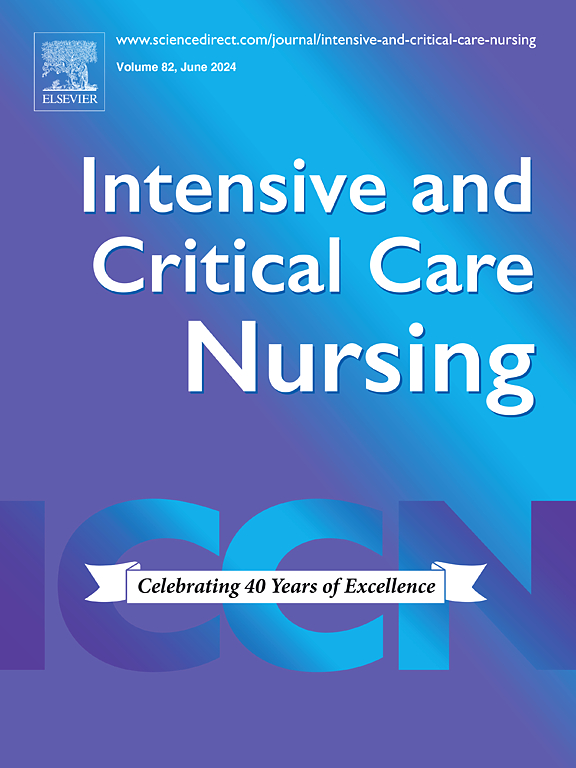A retrospective records review comparing the care of patients who either avoided or were admitted to an ICU following a ward-based deterioration event
IF 4.7
2区 医学
Q1 NURSING
引用次数: 0
Abstract
Objectives
To identify escalation success factors documented in care records of patients who triggered an Early Warning Score ≥ 7 in the ward, avoided an Intensive Care Unit admission and survived and compare these with ward patients who triggered an Early Warning Score ≥ 7, went to intensive care and died during their admission.
Methods
A multi-site, retrospective records review was conducted on 340 survivors and 50 non-survivors who were either admitted to, or who avoided intensive care.
Results
Non-survivors of deterioration tended to be older, earlier into their hospital admission, and had a greater number of co-morbidities at the time of their trigger event. Overall, superior care was observed in non-survivors when triangulating quality of care scores and escalation care quality metrics (escalation compliance, hourly observations, and medical re-evaluation). Survivors avoided an Intensive Care Unit admission through responding to ward management or being referred to a specialist team. However, 9.7 % (33/340) of survivors were still triggering at the time of discharge, and 54 % of these had either Covid-19 or a long-term cardiorespiratory condition.
Conclusions
This study found differences in how clinical staff responded to patient deterioration between survivors and non-survivors. Although non-survivors received higher-rated care and met more escalation quality indicators, their poorer outcomes were likely influenced by more severe underlying conditions. Despite both patient groups having comparable scores, staff appeared to make nuanced judgments factoring in clinical concerns not captured by the score alone (success factor).
Implications for Clinical Practice
Despite generating the same warning score values, there is wide variation in true patient acuity that only clinical staff can discriminate, and escalation protocols alone may not be advanced enough to address this subtlety.
一项回顾性记录回顾,比较了在病房恶化事件后避免或被收治到ICU的患者的护理
目的确定在病房中触发预警评分≥7的患者的护理记录中记录的升级成功因素,避免进入重症监护病房并存活下来,并将其与触发预警评分≥7,进入重症监护并在入院期间死亡的病房患者进行比较。方法采用多地点回顾性资料分析方法,对340例生存患者和50例未生存患者进行重症监护。结果病情恶化的非幸存者往往年龄更大,入院时间更早,并且在触发事件时有更多的合并症。总体而言,当对护理质量评分和升级护理质量指标(升级依从性、每小时观察和医疗再评估)进行三角测量时,在非幸存者中观察到更好的护理。幸存者通过响应病房管理或被转介到专家小组,避免了重症监护病房的入院。然而,9.7%(33/340)的幸存者在出院时仍然触发,其中54%患有Covid-19或长期心肺疾病。本研究发现临床工作人员对幸存者和非幸存者患者病情恶化的反应存在差异。尽管非幸存者获得了更高的护理评级,并达到了更多的升级质量指标,但他们较差的结果可能受到更严重的潜在条件的影响。尽管两组患者的得分相当,但工作人员似乎做出了细致入微的判断,考虑到临床问题,而不仅仅是得分(成功因素)。对临床实践的启示尽管产生相同的警告评分值,但患者的真实敏锐度存在很大差异,只有临床工作人员才能区分,仅凭升级协议可能不足以解决这一微妙之处。
本文章由计算机程序翻译,如有差异,请以英文原文为准。
求助全文
约1分钟内获得全文
求助全文
来源期刊

Intensive and Critical Care Nursing
NURSING-
CiteScore
6.30
自引率
15.10%
发文量
144
审稿时长
57 days
期刊介绍:
The aims of Intensive and Critical Care Nursing are to promote excellence of care of critically ill patients by specialist nurses and their professional colleagues; to provide an international and interdisciplinary forum for the publication, dissemination and exchange of research findings, experience and ideas; to develop and enhance the knowledge, skills, attitudes and creative thinking essential to good critical care nursing practice. The journal publishes reviews, updates and feature articles in addition to original papers and significant preliminary communications. Articles may deal with any part of practice including relevant clinical, research, educational, psychological and technological aspects.
 求助内容:
求助内容: 应助结果提醒方式:
应助结果提醒方式:


